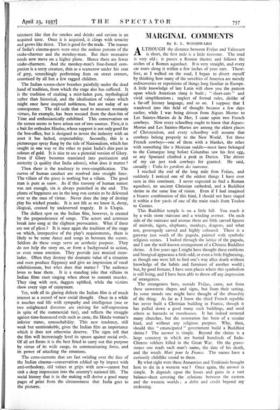MARGINAL COMMENTS
By E. L. WOODWARD
ALTHOUGH the distance between Frejus and Valescure is short, the first mile is a little tiresome. The road is very old ; it passes a Roman theatre and follows the arches of a Roman aqueduct. It is very straight, and every car roars along it within a few inches of your ears. There- fore, as I walked on the road, I began to divert myself by thinking how many of the novelties of America are merely rediscoveries or repetitions of things long familiar in Europe. A little knowledge of late Latin will show you the pattern upon which American slang is built ; " short-cuts " and vivid simplifications ; neglect of formal rules, dislike of a far-off literary language, and so on. I suppose that I wandered into this field of thought because a few days earlier, while I was being driven from Aigues Mortes to Les Saintes-Marios de la Mer, I came upon two French cowboys. Now every schoolboy ought to know that Aigues- Mortes and Les Saintes-Marios are among the oldest places of Christendom, and every schoolboy will assume that cowboys belong properly to the New World. Yet those French cowboys—one of them with a blanket, the other with something like a Mexican saddle—must have belonged to the Camargue long before Columbus saw his first egg, or any Spaniard climbed a peak in Darien. The driver of my car just took cowboys for granted. He said, casually : Voila les gardiens des taureaux.
I reached the end of the long mile fron Frejus, and suddenly I noticed one of the oddest things I have ever seen in this continent. I never expected to find a Roman aqueduct, an ancient Christian cathedral, and a Buddhist shrine in the same line of vision. Even if I had imagined a bizarre combination of this kind, I should not have staged it within a few yards of one of the main roads from Toulon to Cannes.
This Buddhist temple is on a little hill. You reach it by a wide stone staircase and a winding avenue. On each side of the staircase and avenue there are little carved figures of animals, tigers, elephants, monkeys, dragons, and what not, grotesquely carved and highly coloured. There is a gateway just south of the pagoda, painted with symbolic religious scenes. I looked through the lattice of the pagoda, and I saw the well-known arrangement of a Chinese Buddhist shrine. A few years ago I might have thought these emblems and liturgical apparatus a little odd, or even a little frightening, as though one were left to find one's way after death without knowledge of the habits and furniture of another world ; but, by good fortune, I have seen places where this symbolism is still living, and I have been able to throw off any impression of strangeness.
The strangeness here, outside Frejus, came, not from these unwestern shapes and signs, but from their setting. In some moods one might have thought of the absurdity of the thing. As far as I know the third French republic has never built a Christian building in France, though it has pulled down a good many such buildings, and used others as barracks or storehouses. It has indeed restored many churches, but the restoration has been of a secular kind, and without any religious purpose. Why, then, should this " emancipated " government build a Buddhist shrine ? The answer is simple. Beyond the shrine is a large cemetery in which are buried hundreds of Indo- Chinese soldiers killed in the Great War. On the grave- stones one reads each man's name, the date of his death, and the words Mort pour la France. The names have a curiously childlike sound to them.
By what right were these Annamites and Tonkinois brought here to die in a western war ? Once again, the answer is simple. It depends upon the losses and gains in a vast balance-sheet covering the relations between the eastern and the western worlds ; a debit and credit beyond my reckoning.










































 Previous page
Previous page